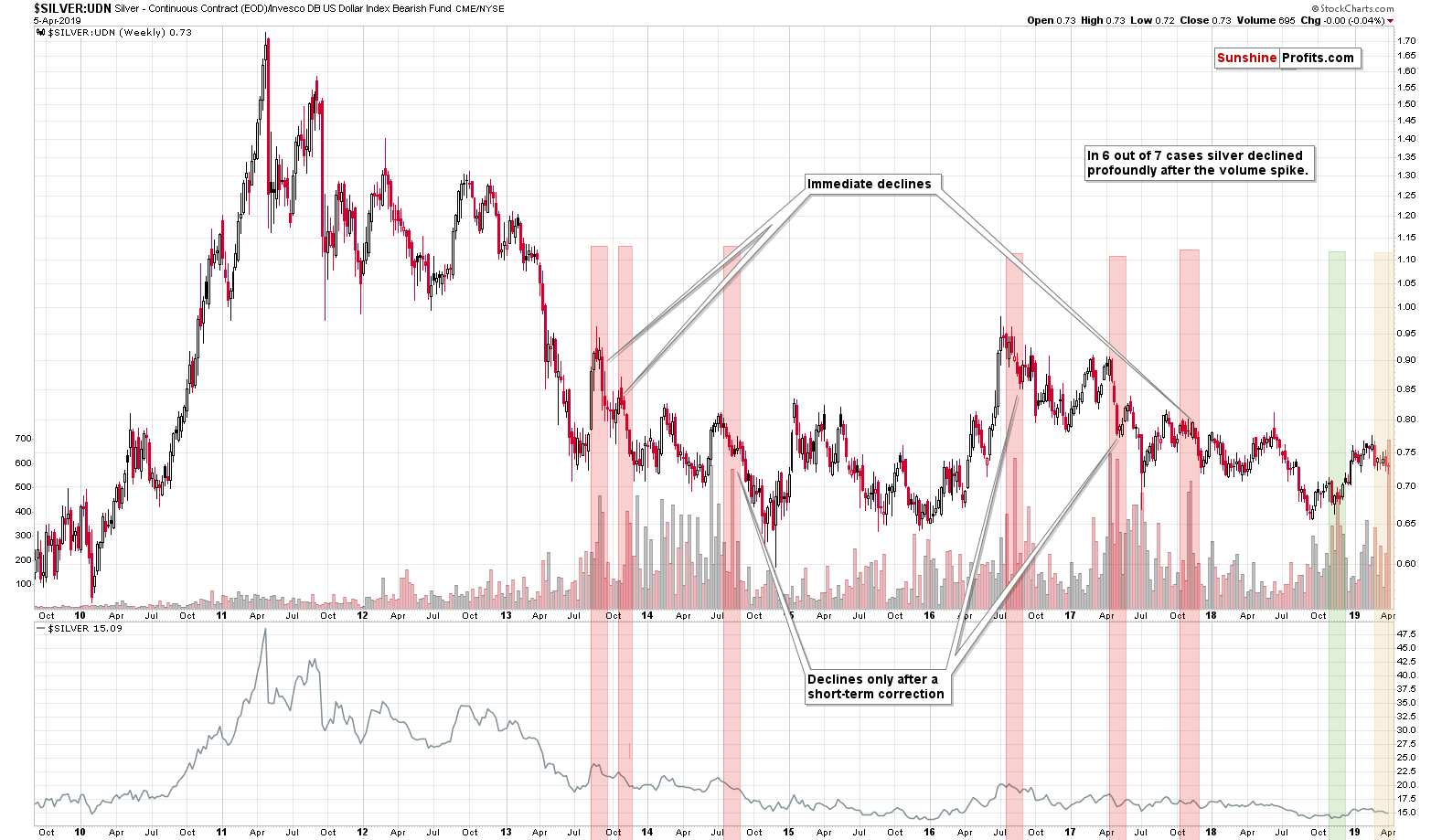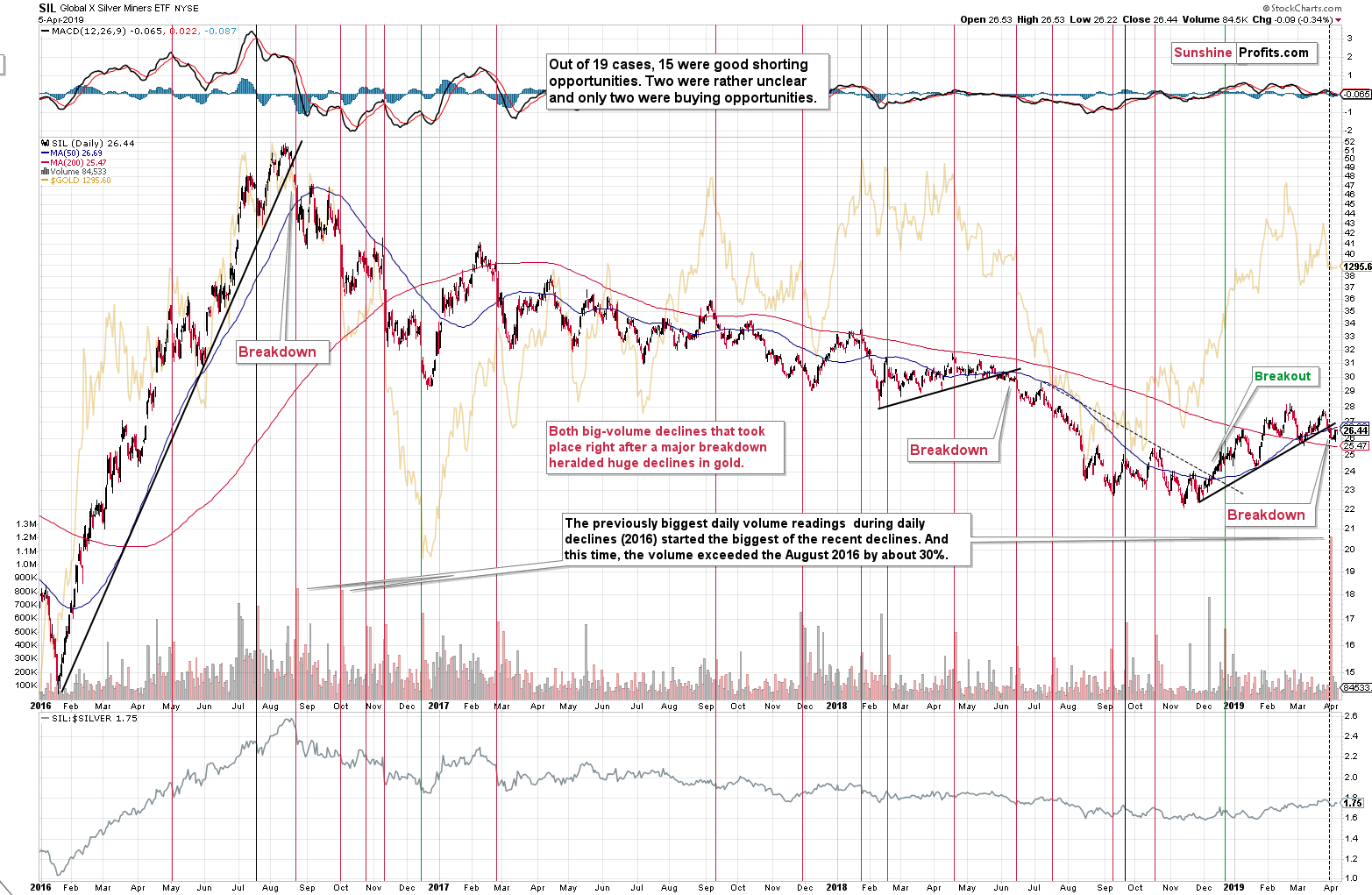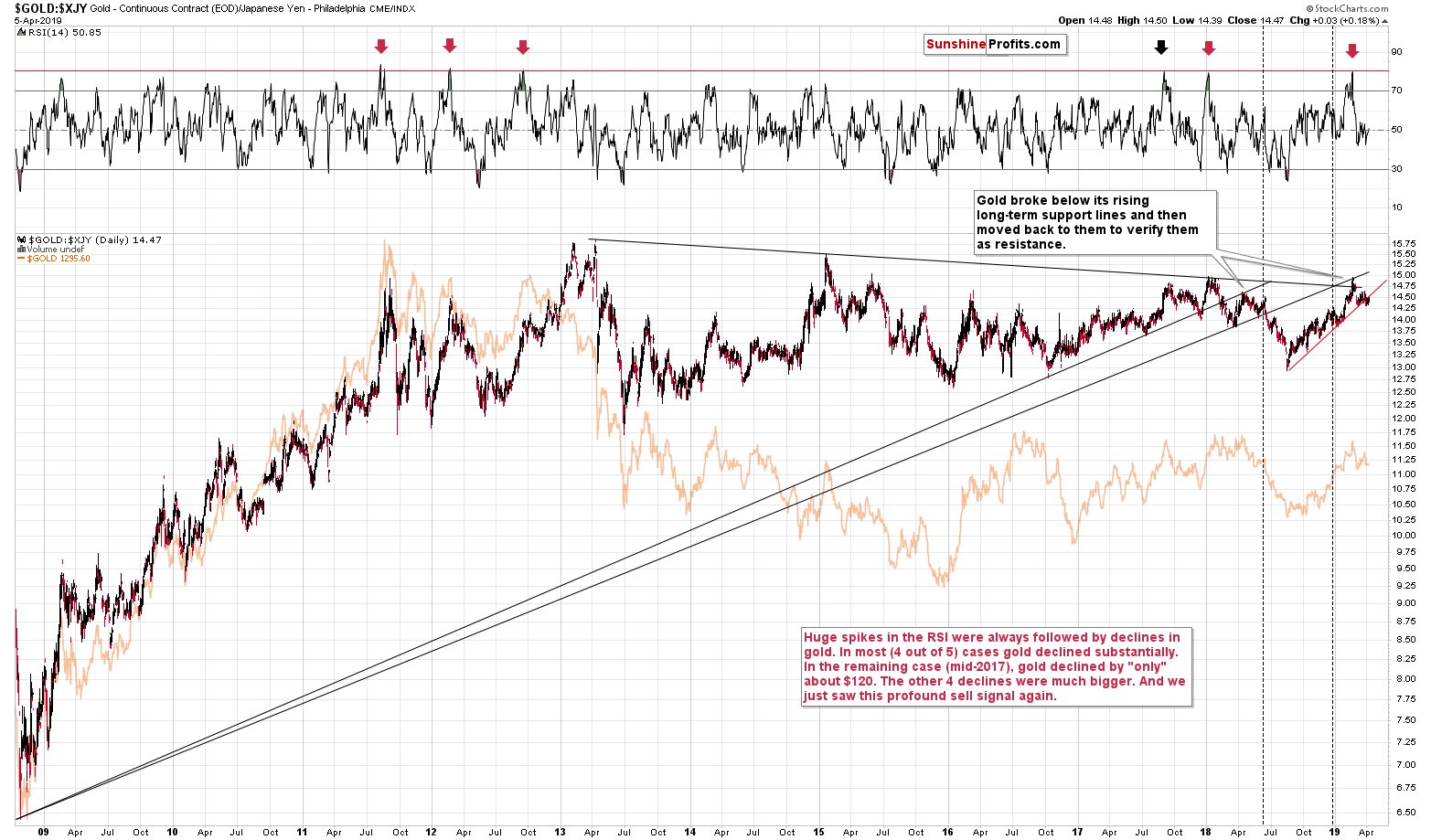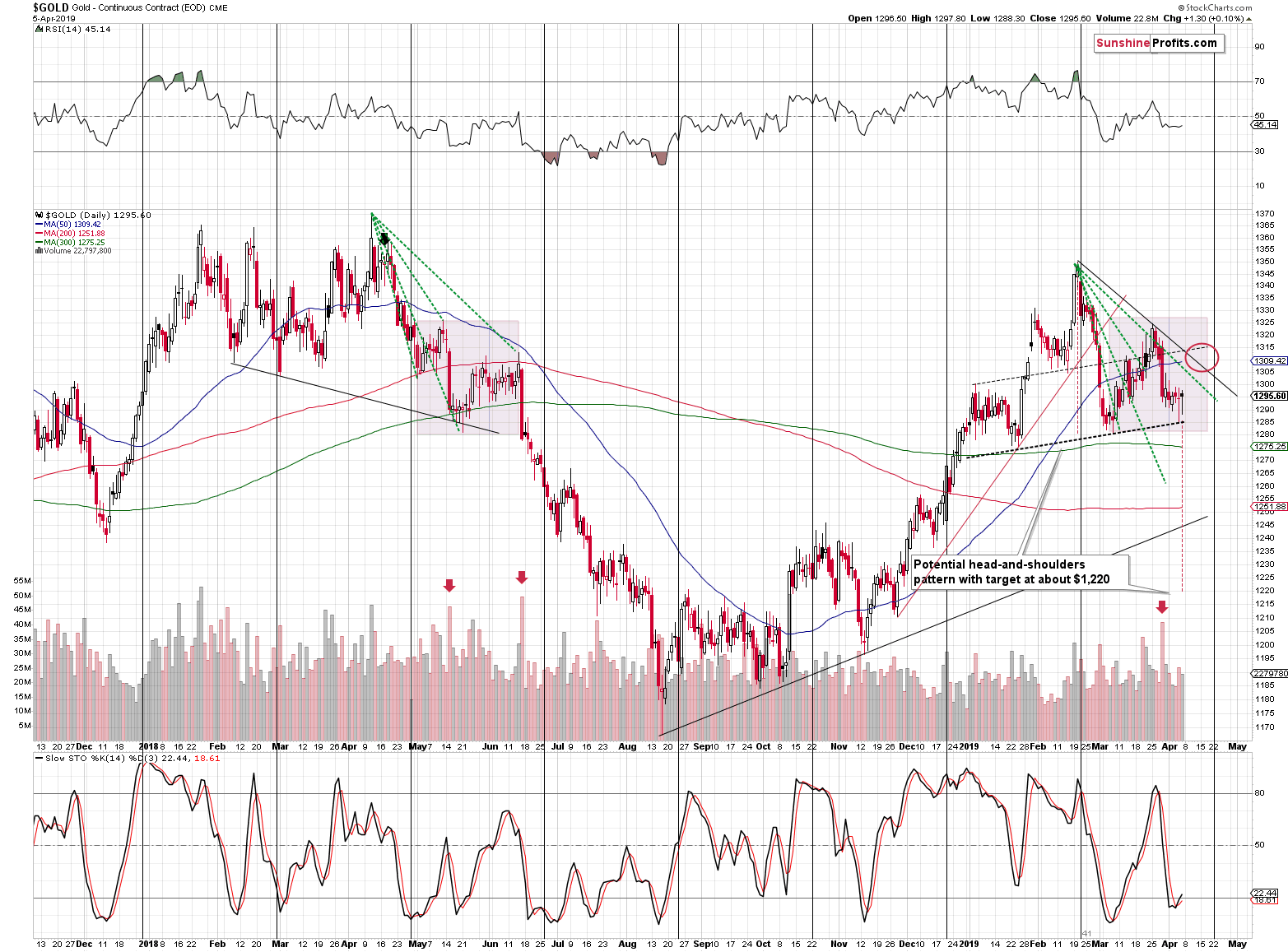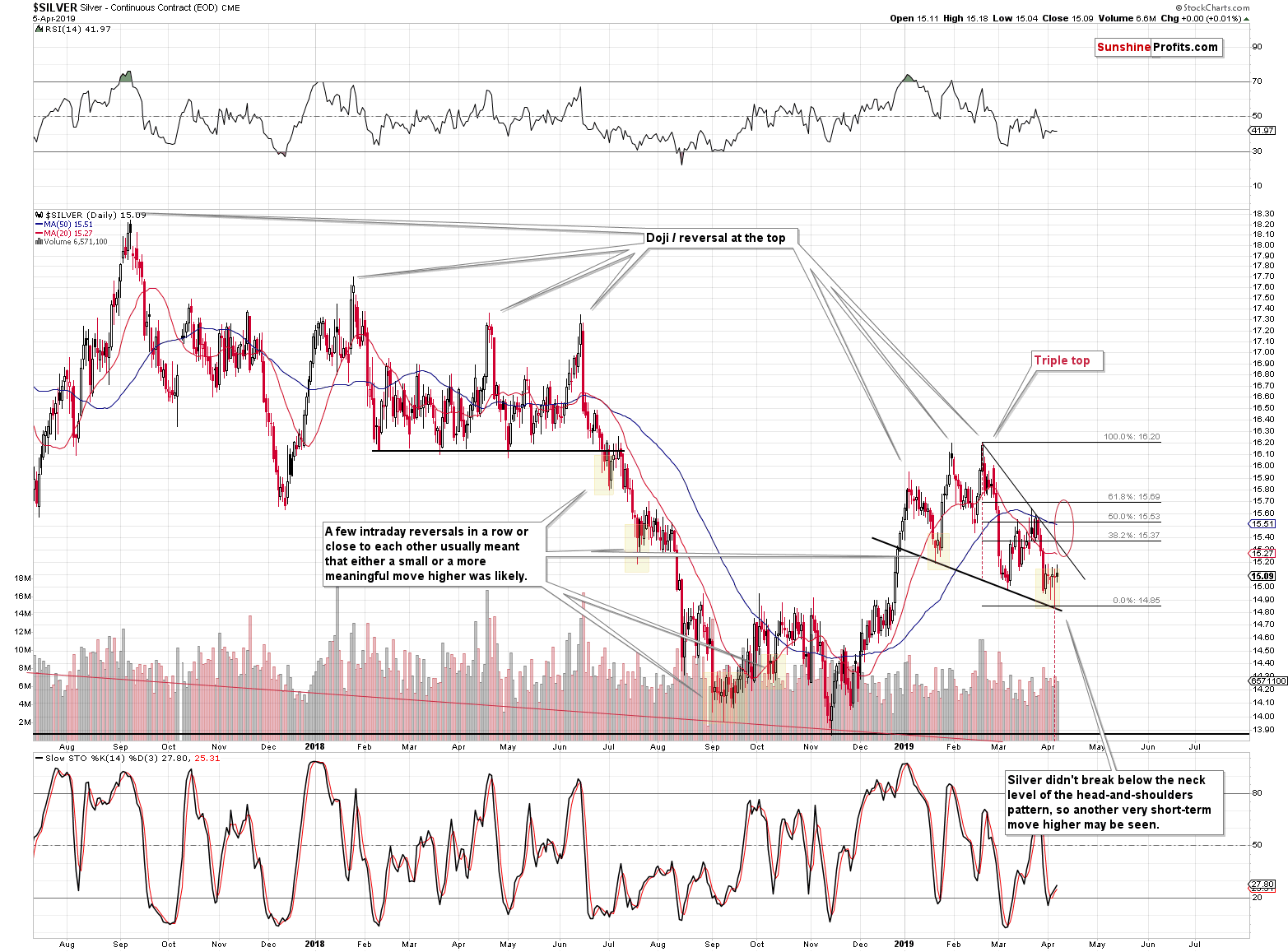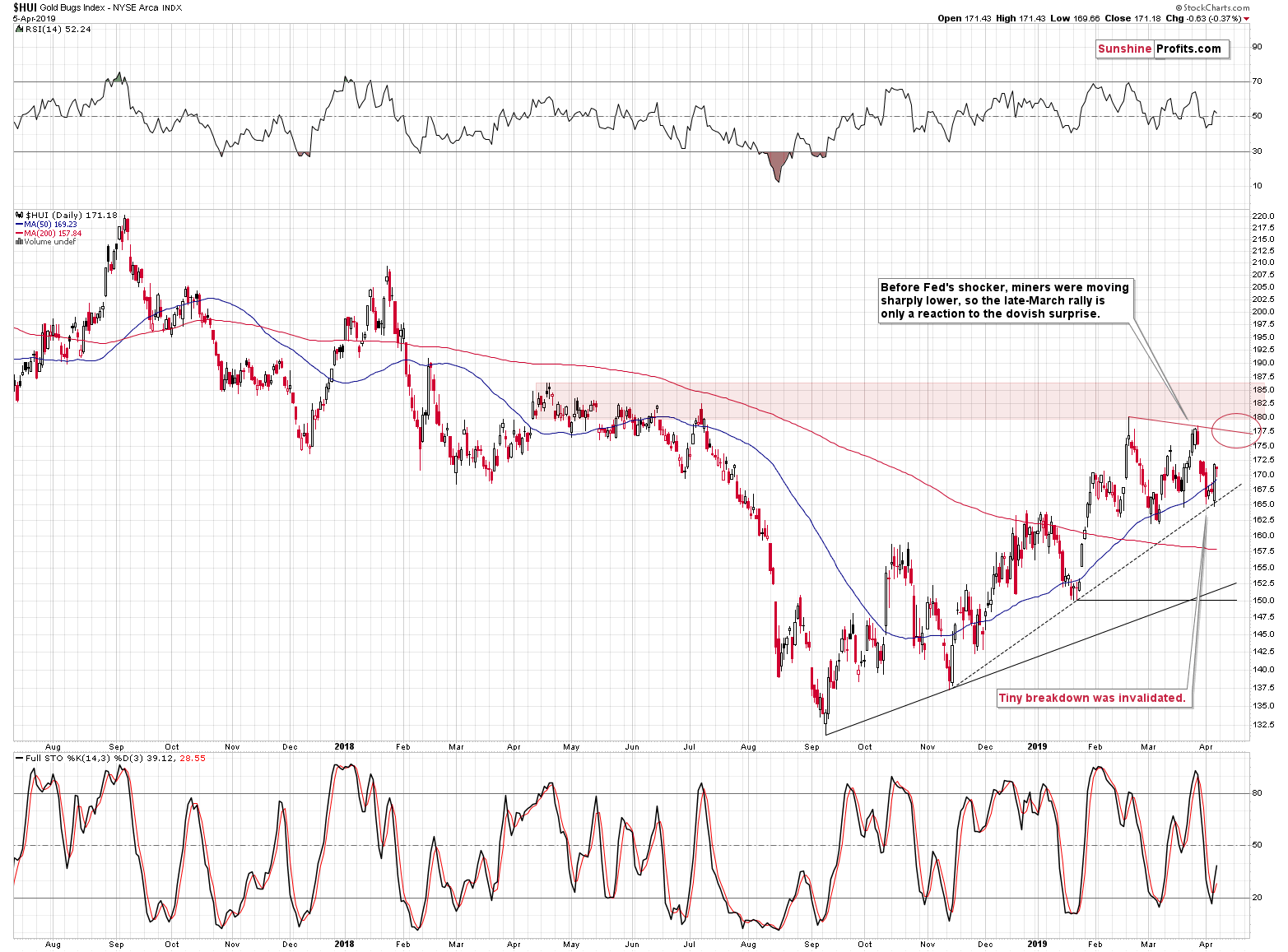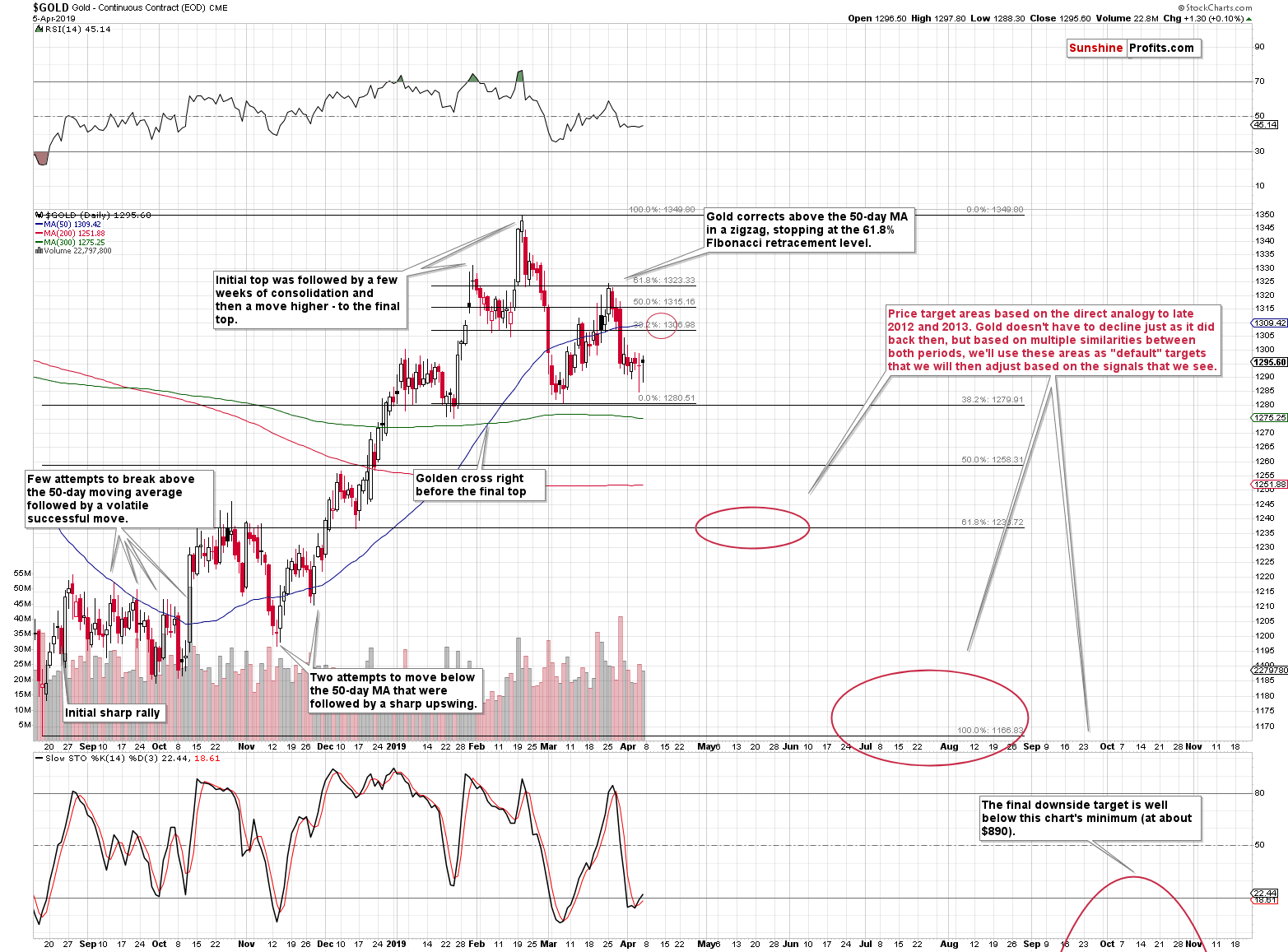Briefly: in our opinion, small (50% of the regular size of the position) speculative short position in gold, silver, and mining stocks is justified from the risk/reward perspective at the moment of publishing this Alert.
One may say that not much has happened last week in case of gold and silver, but it’s impossible to describe the action in mining stocks in the same way. Miners started the previous week with a slide only to come back with vengeance before the week was over, changing the short-term picture for the entire sector. The weekly price changes show little changes as long as you only have a quick glance at them, without really digging into details. We did much more than just a glance. We unearthed… a weekly record. Last week was not as dull – overall – as it seems. It was a record-breaker in one precious-metals-related aspects. And since the implications extend from short- to medium-term, it’s definitely something that PMs traders need to consider. And it’s why we’ll start with it.
Many precious analysts stop their analysis at gold’s US dollar analysis alone. Sometimes they add silver or – at most – mining stocks to the picture. But the focus on key ratios and on gold’s performance in terms of other currencies is rare. Silver’s non-USD performance is almost never discussed. And it’s a shame, because that’s where the current weekly extreme can be found.
Silver’s Non-USD Performance
The above chart shows the silver to UDN ratio chart, which is a proxy for silver’s price in terms of currencies other than the US dollar. The UDN ETN is an inverse vehicle that’s based on the USD Index.
In order to check how silver would be doing without USD’s influence, we need to take the latter “out” of the silver price. If the USD was moving in the same direction as silver, we would simply divide silver’s price by the USD Index and we would get the desired values. But, since USD and precious metals move in opposite ways, we need to do the opposite – we will first inverse the USDX so that it moves – on average - in the same direction as the PMs, and then we will divide silver by it. The UDN ETF is an inverse USDX instrument, so it does exactly the above. The silver to UDN ratio is effectively very close to an indicator of silver strength on its own.
What is so special about the above non-USD silver chart? One thing is that it allows for technical analysis that could point to some developments earlier than in case of the regular USD perspective. That’s not the main point here, though. Besides, using ETNs that have sizable time decay can make their technical analysis considerably less effective than the analysis of the underlying, unleveraged instrument (that’s why it’s a mistake to focus on price formations in leveraged ETNs such as NUGT and DUST).
The special feature of the above chart is not the price, but the volume. And in particular, the ratio of volumes. Whenever people get excited about silver and at the same time they are not excited by the USD Index (at least as far the UDN ETF as a proxy for it shows), we get high readings in the volume. If the difference is huge, we get volume spikes.
Naturally, on a daily basis, there would be many spikes as there can be many individual reasons due to which a the UDN ETN can move on sizable volume, and these spikes would not necessarily be meaningful. But, in case of weekly price changes and weekly volume changes, these individual moves should average out, and the readings that we get should be meaningful.
Moving to the point, the weekly volume spike that we saw last week was the biggest that we ever saw.
Why should you care? Because in 6 out of 7 cases where we saw these huge volume spikes silver plunged either sooner or later. That’s the key implication – the silver picture remains strongly bearish for the medium term.
What is very interesting is the short-term implication. Half of the above-mentioned 6 bearish cases was followed by a decline immediately, but the other half was followed by a short-term upswing before the big move lower resumed. If we add the remaining – bullish – case to the above, we get a 4 out of 7 (57.14%) cases that support the bullish outcome in the near term.
This is in perfect tune with last week’s bullish reversal in gold, silver, and – especially – mining stocks.
This is also in perfect tune with what we have featured last week as an important, yet little known, extreme sign from the silver sector. Silver’s non-USD chart is not the only silver place where we saw record-setting volume spike. Silver stocks provided the heads-up even earlier.
Silver Stocks Lead In
We wrote about on Wednesday, and it seems worth quoting the analysis also today – it remains up-to-date.
Gold price usually moves in tune with the silver price, and silver stocks usually move in tune with silver. The sizes of the moves are not identical, but the turnarounds often take place at the same time. The price moves are similar enough to say that the big moves will take place at the same time, but they are different enough for the markets to provide different signals. At times, one market might lead the other. There may also be other specific features and in today’s Alert, we’ll focus on one of them.
Namely, we’re going to discuss the huge daily volume spikes. And in particular, we’re going to focus on days when the silver miners (were using the SIL ETF as a proxy for the sector) declined on big volume. There were quite a few such days since early 2016 and they were almost all characterized by analogous price action - not only in the case of silver miners, but also in the case of gold.
To put it simply, gold usually took a dive after silver miners declined on huge volume.
The above doesn’t reveal the efficiency, nor the severity of the signal, though.
As far as efficiency is concerned, there were 19 signals and 15 of them were good (or excellent) shorting opportunities. In two cases, it was unclear if it was a good shorting opportunity or not. There were only two cases when the signal clearly failed: in December 2016 and in December 2018.
The professional approach is to focus on the losses or things that invalidate a given theory first, and that’s exactly what we’re going to do now. Let’s start with the two cases that were actually buying opportunities. In the opening paragraph, we have mentioned that these two cases are not similar to the current situation. Both cases took place in December and we’re far from this month, but that’s not the main point.
The main point is that in the first – 2016 – case, both: gold and silver miners were already after a several-month-long decline and thus big volume might have really signified the exhaustion of the trend. The second – 2018 – case is when silver miners were right after a breakout. Not only are the miners not after a breakout right now, but they are actually after a breakdown.
Having said that, let’s move to the two unclear cases. One of them was mid-July 2016 case where the market moved higher one more time before forming the final top, and the other one was the September 2018 situation, when the market moved lower in the near term, but that was actually the start of a bigger upleg. One case was a good shorting opportunity in the medium term, but a bad one in the near term, and the other case was the opposite. None of them clearly invalidated the signal, but to be conservative, we can say that only one additional case confirmed the signal, while the other one didn’t. This means that we get the ultimate efficiency of 84.2% (16 out of 19). That’s an extremely high efficiency and…
That’s not everything.
You see, the very recent price/volume action in silver stocks was not average. It was special. There are two reasons for it:
- The daily volume was higher than what we saw previously. In fact, it was highest daily volume that we ever saw in case of the SIL ETF.
- The volume spike took place right after a major breakdown.
Monday’s volume in the silver miners was no April Fools’ Day joke. It exceeded the previous record by about 30%. Out of the recent years, we saw the biggest daily volume during a decline in silver in 2016: in August and September. That was the beginning of the biggest decline in gold of the recent years. In other words, the only analogy that we have based on the size of the volume points to the biggest decline in the recent history. And the volume was even bigger this time – it broke the previous record. Will the decline be bigger than the late-2016 one? That’s what is very likely based on many other techniques and what the above silver chart is confirming.
Moving to the second point, silver miners are right after a major breakdown. There were two similar breakdowns in the recent past that were then followed by the huge-volume signal. That was in August 2016 and in June 2018. In both cases, silver miners and gold continued to decline for many weeks.
Both the above-mentioned factors suggest that 84.2% efficiency is likely understated and should in reality be higher. In particular, both links point to analogy between the current situation and what we saw in August 2016. It then took gold less than 4 months to decline over $200. And let’s keep in mind that the volume was much higher this time, so the move – based on the above chart alone – could also be bigger this time.
There are two things that we would like to add to the above quote based on the recent short-term developments:
- Silver miners broke below their rising black support line and the recent upswing serves as a verification of the breakdown – it’s not bullish, it’s a natural part of a bigger, bearish move.
- The silver miners’ chart shows that the December 2018 case is not as the current situation, and in case of the silver’s non-USD chart, the only case when the white metal didn’t decline in tune with the other cases was in late November 2018 – very close to the above-mentioned case. The only case that invalidates the analogy seems to be less relevant than other cases, which increases the reliability of the silver’s non-USD volume spike signal and its bearish implications for the medium term.
Still, the above doesn’t rule out the possibility of seeing a short-term upswing before the decline resumes. Silver stocks would likely simply verify their breakdown in this case.
Speaking of breakdowns, their verifications, and non-USD precious metals charts, we have something very much in tune with the above in case of gold priced in terms of the Japanese yen.
Gold, Japanese Yen and the USD Perspective
Gold broke below the rising medium-term red support line and the breakdown has not been invalidated. Conversely, it was confirmed. This means that the decline is likely to resume shortly, but not necessarily immediately. Gold could move even closer to the previously broken line before turning south again.
Let’s take a look at Friday’s price developments from our regular USD perspective.
Gold formed another daily reversal, which simply confirms the points that we made previously. What we would like you to remember here is the extent of the intraday move lower – gold almost reached its very recent lows.
Glance at Silver
Silver also did very little. It just moved back and forth. This kind of performance doesn’t change anything that we wrote previously, as this is what silver did in some cases after the temporary reversal bottom. Mid-July and September 2018 serve as examples.
Gold Miners: Fitting into the 2012-2013 - Now Link in Gold
Just below the gold chart, we asked you to remember how low gold moved on an intraday basis. It was almost to the previous intraday low. The point was to compare it to the size of the intraday move lower in case of the gold stocks. It was not even very close to the half of the distance to the recent intraday low. Gold miners once again showed some very short-term strength, which is a bullish sign for the short term. While PMs remain in a medium-term downtrend, they are likely to move a bit higher in the near term before the decline resumes.
Before summarizing, we would like to address one key issue that you are probably wondering about – how does the possibility (and, in fact, likelihood) of the short-term upswing in gold relate to the analogy to the 2012-2013 performance.
In short, it perfectly fits it.
On March 26th, right after gold reached its 61.8% Fibonacci retracement, we wrote that this move was not a game-changer, but rather something in exact tune with the past pattern, and we suggested staying short. We emphasized that based on the 2012-2013 – now analogy, that was the likely top that was in tune with the late-November 2012 top. The top has indeed formed, and the price declined almost to the previous lows.
The “almost” part is important, because that exactly what happened in 2012. In early December 2012, price reversed (a few times in a row – just like what we just saw) and gold started a small corrective upswing.
The price target based on the analogy is between $1,307 (the 38.2% Fibonacci retracement based on the previous decline) and $1,310 – the 50-day moving average. Both levels triggered a reversal in gold in 2012 and the same might also be the case this time.
Please note that the above is in perfect tune with what we wrote about the target for this upswing based on other techniques. On Friday, we wrote that we expect gold to top in the $1,305 - $1,315 area and the above $1,307 - $1,310 range is right in its middle.
Gold is likely to move higher from here, but not very far. Right now, gold is up by about $5 in today’s pre-market trading. This move is something that those more short-term-oriented may want to take advantage of, but due to the multiple long-term signals that favor bearish surprises and the target being relatively close, we will keep our short position intact. We will keep it small, though, and we will aim to increase it once again once gold moves higher.
Summary
Summing up, it’s almost certain that the next big move lower has already begun and that the 2013-like slide is in its early stage. The early stage is not as volatile as the final stage and periodic corrections may take place. It seems that one of them will take place in the next week or two. The medium-term downtrend remains confirmed by multiple strong signals, so the bullish implications of yesterday’s reversal are only for the short term. Gold is likely to move higher shortly, but not very far. The target area is between $1,305 and $1,315, with $1,310 being the most likely target.
As always, we will keep you – our subscribes – informed.
To summarize:
Trading capital (supplementary part of the portfolio; our opinion): Small short position (50% of the full position) in gold, silver, and mining stocks is justified from the risk/reward perspective with the following stop-loss orders and exit profit-take price levels:
- Gold: profit-take exit price: $1,062; stop-loss: $1,357; initial target price for the DGLD ETN: $82.96; stop-loss for the DGLD ETN $39.87
- Silver: profit-take exit price: $12.32; stop-loss: $16.44; initial target price for the DSLV ETN: $47.67; stop-loss for the DSLV ETN $23.68
- Mining stocks (price levels for the GDX ETF): profit-take exit price: $13.12; stop-loss: $24.17; initial target price for the DUST ETF: $76.87; stop-loss for the DUST ETF $15.47
Note: the above is a specific preparation for a possible sudden price drop, it does not reflect the most likely outcome. You will find a more detailed explanation in our August 1st Alert. In case one wants to bet on junior mining stocks’ prices (we do not suggest doing so – we think senior mining stocks are more predictable in the case of short-term trades – if one wants to do it anyway, we provide the details), here are the stop-loss details and target prices:
- GDXJ ETF: profit-take exit price: $17.52; stop-loss: $35.67
- JDST ETF: initial target price: $143.87 stop-loss: $30.97
Long-term capital (core part of the portfolio; our opinion): No positions (in other words: cash)
Insurance capital (core part of the portfolio; our opinion): Full position
Whether you already subscribed or not, we encourage you to find out how to make the most of our alerts and read our replies to the most common alert-and-gold-trading-related-questions.
Please note that the in the trading section we describe the situation for the day that the alert is posted. In other words, it we are writing about a speculative position, it means that it is up-to-date on the day it was posted. We are also featuring the initial target prices, so that you can decide whether keeping a position on a given day is something that is in tune with your approach (some moves are too small for medium-term traders and some might appear too big for day-traders).
Plus, you might want to read why our stop-loss orders are usually relatively far from the current price.
Please note that a full position doesn’t mean using all of the capital for a given trade. You will find details on our thoughts on gold portfolio structuring in the Key Insights section on our website.
As a reminder – “initial target price” means exactly that – an “initial” one, it’s not a price level at which we suggest closing positions. If this becomes the case (like it did in the previous trade) we will refer to these levels as levels of exit orders (exactly as we’ve done previously). Stop-loss levels, however, are naturally not “initial”, but something that, in our opinion, might be entered as an order.
Since it is impossible to synchronize target prices and stop-loss levels for all the ETFs and ETNs with the main markets that we provide these levels for (gold, silver and mining stocks – the GDX ETF), the stop-loss levels and target prices for other ETNs and ETF (among other: UGLD, DGLD, USLV, DSLV, NUGT, DUST, JNUG, JDST) are provided as supplementary, and not as “final”. This means that if a stop-loss or a target level is reached for any of the “additional instruments” (DGLD for instance), but not for the “main instrument” (gold in this case), we will view positions in both gold and DGLD as still open and the stop-loss for DGLD would have to be moved lower. On the other hand, if gold moves to a stop-loss level but DGLD doesn’t, then we will view both positions (in gold and DGLD) as closed. In other words, since it’s not possible to be 100% certain that each related instrument moves to a given level when the underlying instrument does, we can’t provide levels that would be binding. The levels that we do provide are our best estimate of the levels that will correspond to the levels in the underlying assets, but it will be the underlying assets that one will need to focus on regarding the signs pointing to closing a given position or keeping it open. We might adjust the levels in the “additional instruments” without adjusting the levels in the “main instruments”, which will simply mean that we have improved our estimation of these levels, not that we changed our outlook on the markets. We are already working on a tool that would update these levels on a daily basis for the most popular ETFs, ETNs and individual mining stocks.
Our preferred ways to invest in and to trade gold along with the reasoning can be found in the how to buy gold section. Additionally, our preferred ETFs and ETNs can be found in our Gold & Silver ETF Ranking.
As a reminder, Gold & Silver Trading Alerts are posted before or on each trading day (we usually post them before the opening bell, but we don't promise doing that each day). If there's anything urgent, we will send you an additional small alert before posting the main one.
=====
Latest Free Trading Alerts:
Stocks extended their short-term uptrend on Friday, as investors' sentiment remained bullish following the monthly jobs data release. The S&P 500 index got closer to its last year's September record high. But will the uptrend continue despite some technical overbought conditions?
S&P 500 at New Medium-Term High, but Correction May Be Coming
=====
Thank you.
Sincerely,
Przemyslaw Radomski, CFA
Editor-in-chief, Gold & Silver Fund Manager


